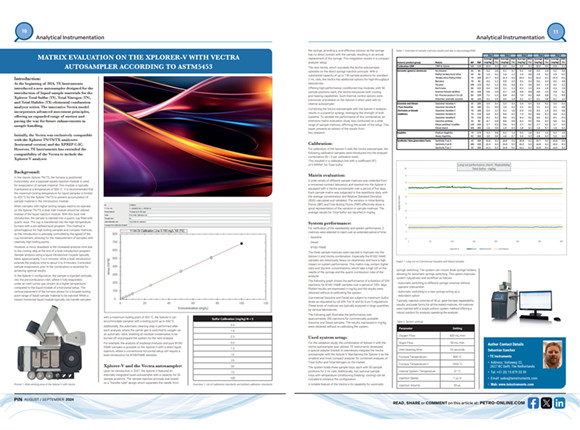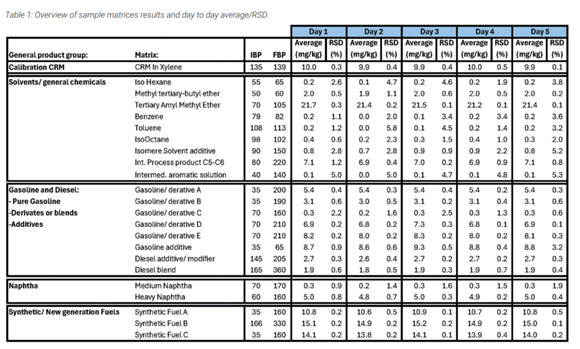Home > News > Matrix Evaluation on the XPLORER-V with VECTRA Autosampler According to ASTM5453
Matrix Evaluation on the XPLORER-V with VECTRA Autosampler According to ASTM5453

Introduction:
At the beginning of 2024, TE Instruments introduced a new autosampler designed for the introduction of liquid sample materials for the Xplorer Total Sulfur (TS), Total Nitrogen (TN), and Total Halides (TX) elemental combustion analyzer series. The innovative Vectra model incorporates advanced movement principles, offering an expanded range of motion and paving the way for future enhancements in sample handling. Initially, the Vectra was exclusively compatible with the Xplorer TN/TS/TX analyzers (horizontal version) and the XPREP C-IC. However, TE Instruments has extended the compatibility of the Vectra to include the Xplorer-V analyzer.

Background:
In the classic Xplorer TN/TS, the furnace is positioned horizontally, and a separate liquids injection module is used for evaporation of sample material. This module is typically maintained at a temperature of 500 °C. It is recommended that the maximum boiling temperature for liquid samples is limited to 420 °C for the Xplorer TN/TS to prevent accumulation of sample material in the introduction module. When samples with higher boiling ranges need to be injected on the Xplorer TN/TS, a boat inlet module should be utilized instead of the liquid injection module. With this boat inlet introduction, the sample is injected into a quartz cup filled with quartz wool. The cup is transferred into the high-temperature furnace with a pre-defined boat program. This method is advantageous for high boiling samples and complex matrices, as the introduction is precisely controlled by the speed of the cup movement, allowing for the measurement of samples with relatively high boiling points. However, a minor drawback is the increased analysis time due to the cooling step at the end of a boat introduction program. Sample analysis using a liquid introduction module typically takes approximately 3 to 6 minutes, while a boat introduction extends the analysis time to about 5 to 9 minutes. Controlled sample evaporation prior to the combustion is essential for achieving optimal results. In the Xplorer-V configuration, the sample is injected vertically into the pre-combustion inlet, where it fully evaporates under an inert carrier gas stream at a higher temperature compared to the liquid module of a horizontal setup. The vertical placement of the furnace allows for a broader boiling point range of liquid sample material to be injected. While a classic horizontal liquid module typically can handle samples with a maximum boiling point of 420 °C, the Xplorer-V can accommodate samples with a boiling point up to 650 °C. Additionally, the automatic cleaning step is performed after each analysis, where the carrier gas is switched to oxygen via an automatic valve, enabling all residual condensates to be burned off and prepare the system for the next analysis. For example, the analysis of biodiesel mixtures and pure B100/ FAME samples is possible on the Xplorer-V with a direct liquid injection, where a conventional horizontal setup still require a boat introduction for B100/FAME samples.


Xplorer-V and the Vectra autosampler: Upon its introduction in 2021, the Xplorer-V featured an internally integrated liquid autosampler with a capacity for 26 sample positions. The sample injection principle was based on a “transfer tube” design which separates the needle from the syringe, providing a cost-effective solution as the syringe has no direct contact with the sample, resulting in an annual replacement of the syringe. This integration results in a compact analyzer setup. The new Vectra, which succeeds the Archie autosampler, operates on the direct syringe injection principle. With a substantial capacity of up to 150 sample positions for standard 2 mL vials, the Vectra has additional options for high-throughput laboratories. Offering high-performance conditioned tray modules, with 50 sample positions each, the Vectra introduces both cooling and heating capabilities. Such thermal control options were previously unavailable on the Xplorer-V when used with its internal autosampler. Combining the Vectra autosampler with the Xplorer-V analyzer results in a powerful synergy, leveraging the strength of both systems. To validate the performance of this combination, an extensive matrix evaluation study was conducted on a wide range of sample matrices, affirming the power of the setup. This paper presents an extract of the results from this research.

Calibration:
For calibration of the Xplorer-V with the Vectra autosampler, the following calibration samples were introduced into the analyzer combination (N = 5 per calibration level). This resulted in a calibration line with a coefficient (R2 ) of 0.999941 for Total Sulfur.
Matrix evaluation:
A wide variety of different sample matrices was collected from a renowned contract laboratory and injected into the Xplorer-V equipped with a Vectra autosampler over a period of five days. Each sample matrix was subjected to five repetitions daily, with the average concentration and Relative Standard Deviation (RSD) calculated and validated. The variation in Initial Boiling Points (IBP) and Final Boiling Points (FBP) effectively show a good representation of the variation in sample matrices. The average results for Total Sulfur are reported in mg/kg.
System performance:
For verification of the repeatability and system performance, 3 matrices were selected to inject over an extended period of time: – Gasoline – Diesel – B100/ FAME The three sample matrices were injected in triplicate into the Xplorer-V and Vectra combination. Especially the B100/ FAME samples are notoriously heavy on cleanliness and have a high impact on system performance. This matrix may contain higher salts and Glycerin concentrations, which take a high toll on the needle of the syringe and the quartz combustion tube of the analyzer. The following graph shows the performance of a duration of 534 injections for B100/ FAME samples over a period of 100+ days. Plotted results are expressed in mg/kg and the results were obtained without re-calibrating the system. Commercial Gasoline and Diesel are subject to maximum Sulfur levels as stipulated by US EPA Tier III and EU Euro 5 regulations. These kinds of matrices are typically analyzed in large quantities by various laboratories. The following part illustrates the performance over approximately 350 injections for commercially available Gasoline and Diesel samples. The results, expressed in mg/kg, were obtained without re-calibrating the system.


Used system setup:
For the validation study, the combination of Xplorer-V with the Vectra autosampler was utilized. TE Instruments developed a special adapter bracket to seamlessly integrate the Vectra autosampler with the Xplorer-V. Maintaining the Xplorer-V as the smallest and most compact analyzer for combined analyses of Total Sulfur and Total Nitrogen on the market. The system holds three sample trays, each with 50 sample positions for 2 ml vials. Additionally, two optional sample trays with temperature conditioning (heating/ cooling) can be included to enhance the configuration. A notable feature of the Vectra is its capability for automatic syringe switching. The system can mount three syringe holders, allowing for automatic syringe switching. This option improves system robustness and workflow as follows: – Automatic switching to different syringe volumes without operator intervention – Automatic switching to a new syringe acting as a redundant option Typically, injection volumes of 50 μL gave the best repeatability, results, and peak forms for all the tested matrices. All matrices were injected with a single uniform system method offering a robust solution for analysts operating the analyzer.

Author: Sebastian Sanchez
Related News
- How to Achieve Breakthroughs in Immunology and Cancer Therapy Research Using PD- 12/5/2025
- Is There an Inevitable Link Between PD-1 Antibody Half-Life and Clinical Efficac 12/4/2025
- Biotech Fluidics: Dual Stage Degasser Vacuum Pump 12/4/2025
- Can Lactylation Antibodies Reveal New Mechanisms of Tumor Resistance to Ferropto 12/3/2025
- The Application and Validation of Serine/Threonine Phosphorylation Antibodies in 12/2/2025
- Biomoneta Becomes the First Indian Health-Tech Firms to Earn US-FDA Class II Cle 12/2/2025
- Thrombin Antibodies: How Does Aptamer Technology Revolutionize Anticoagulation T 12/1/2025
- The Key Role and Application Advances of IFN-γ Detection in CAR-T Cell Therapy D 11/30/2025
- FMC63 scFv: The Core Component of CD19-Targeted CAR-T Therapy and the Applicatio 11/29/2025
- Olympus Accelerates Local Production of the EVIS X1™ Endoscopy System in C 11/28/2025


